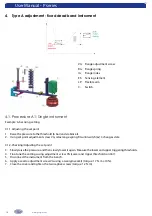
User Manual - P series
3
www.georgin.com
I.
Introduction
You have just acquired a GEORGIN instrument that has undergone extensive testing and several quality
checks to ensure your complete satisfaction.
Appropriate specification, according to your process, and compliance with the instructions in this manual will
ensure an optimum working life for your instrument.
1.
Purpose
P Series instruments are intended for process monitoring.
This manual gives the assembly and configuration instructions to be applied for optimum operation of your
instrument. You must read and obey these instructions when installing your instrument.
!
Never tamper with components of the instrument that are immobilised with red varnish.
Any damage caused by a failure to obey these instructions will invalidate the manufacturer's
guarantee.
2.
Operating principle
VG:
RG:
IG:
IE :
RE:
VE:
ES:
LP:
LE:
C:
Range adjustment screw
Range spring
Range index
Dead band and offset index
Dead band adjustment and offset spring
Dead band adjustment and offset screw
Sensing element
Flexible arm
Dead band arm
Switch
The pressure or temperature is applied to the sensing element (ES), whose position then changes, acting on
the flexible arm (LP). The force produced in this way is balanced by the spring (RG). This is how the set point is
adjusted. As the set point is approached, the change in forces disturbs the balance and acts on the contact.
A second spring (RE) acting on the end of the flexible arm (LP) increases the deviation of the switch(es). The
force produced by the dead band spring is adjustable, and is used to offset the two contacts in the case of
differential functions.
NOTE: The pressure switch and temperature switch scales indicated in our catalogue are values for a set point
to lower the pressure or temperature.
3.
Pressure Equipment Directive (PED)
Series P pressure and temperature switches satisfy the requirements set forth in Appendix I of PED 2014/68/EU. They
are classified in Category IV as a safety accessory, and can be incorporated in a safety loop. Refer to our declaration of
compliance for the models concerned and conditions of use.




































